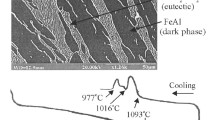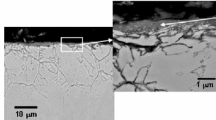Abstract
The contact angles of liquid silver-copper oxide/alumina and liquid copper-copper oxide/alumina systems were determined using the sessile drop method. Copper oxide (CuO) additions of 1.5–10.0 wt% were made. Temperatures of 970–1250 °C for the silver-based alloys and 1090–1300 °C for the copper-based alloys were studied. Minimum contact angles of 42±8 and 64±7 ° were obtained for the copper-copper oxide alloys and the silver-copper oxide alloys, respectively. The contact angle was approximately constant for the silver-copper oxide alloy within the immiscible liquid composition range. While the contact angles were higher for the silver-based alloys relative to the copper-based alloys, successful infiltration of a porous alumina sample was achieved at only 1050 °C for a Ag-10 wt% CuO alloy. Compression tests on infiltrated samples revealed similar compressive strengths for alumina samples infiltrated with silver-copper oxide alloys, silver-copper-copper oxide alloys and copper-copper oxide alloys. The compressive fracture strength for the infiltrated samples was an order of magnitude higher than the fracture strength of the porous alumina body without infiltration. Although silver-based alloys are more expensive than comparable copper-based alloys, in many applications the additional cost may be offset by lower processing or brazing temperatures, improved thermal and electrical conductivity, and improved toughness.
Similar content being viewed by others
References
M. R. Ritland andD. W. Ready,Ceram. Engng. and Sci. Proc. 14 (1993) 896.
Y. Yoshino andT. Shibata,J. Amer. Ceram. Soc. 75 (1992) 2756.
C. Beraud, M. Courbiere, C. Esnouf, D. Juve andD. Treheux,J. Mater. Sci. 24 (1989) 4545.
S. T. Kim andC. H. Kim,ibid. 27 (1992) 2061.
Y. Yoshino,J. Amer. Cer. Soc. 72 (1989) 1322.
B. Gallois andC.H.P. Lupis,Met. Trans. B 12B (1981) 549.
P. D. Ownby andJ. Liu,J. Adhesion Sci. Technol. 2 (1988) 255.
T. E. O'Brien andA.C.D. Chaklader,J. Amer. Ceram. Soc. 57 (1974) 329.
A. C. D. Chaklader, A. M. Armstrong andS. K. Misra,ibid. 51 (1968) 630.
M. B. Baldwin, MS Thesis #4380, Colorado School of Mines, Golden, CO (1993).
Y. Naidich,Prog. in Surf. and Membr. Sci. 14 (1981).
S. P. Mehorta andA. C. D. Chaklader,Met. Trans. B 16B (1985) 567.
D. Chatain, M. L. Muolo andR. Sangiorgi, “Designing ceramic interfaces: understanding and tailoring interfaces for coating, composites and joining applications”, (CEC Publ., Luxembourg, 1993) p. 359.
G. Bernard andC. H. P. Lupis,Met. Trans. 2 (1971) 2991.
J. E. McDonald andJ. G. Eberhart,Trans. AIME 233 (1965) 512.
B.C. Allen andW. D. Kingery,ibid. 215 (1959) 30.
G. Bernard andC.H.P. Lupis.Met. Trans. 2 (1971) 555.
T. Massalski (Ed.), “Binary alloy phase diagrams” (ASM International, Materials Park, OH, 1990) p. 1447.
Z. B. Shao, K. R. Liu, L. Q. Liu, H. K. Liu andS.-X. Dou,J. Amer. Ceram. Soc. 76 (1993) 2663.
“Thin film substrate technical specifications 10-2-0692” (Coors Ceramics Company-Electronics, Golden, CO).
A. Meier, PR. Chidambaram, v. Gabriel andG. R. Edwards in “Processing and fabrication of advanced materials III” (Conference Proceedings, TMS/ASM Materials Week, Oct. 1993, Pittsburgh) p. 47.
L. R. Fisher,J. Colloid Interface Sci. 72 (1979) 200.
T. Iida andR. I. L. Guthrie, “The physical properties of liquid metals” (Clarendon Press, Oxford, 1988).
A. Butts, “Copper: the science and technology of the metal, its alloys and compounds” (Reinhold Publishing Corp., New York, 1954), Ch. 17, 19, 22.
A. Butts andC. D. Coxe, “Silver: economics, metallurgy and use” (D. Van Nostrand Company, Inc., Princeton, NJ, 1967), Ch. 7–9, 20.
N. Birks andG. H. Meier, “Introduction to high temperature materials” (Edward Arnold (Publishers) Ltd, London, 1993).
L. H. Van Vlack, “Elements of materials science and engineering”, 5th Ed (Addison-Wesley Publishing Company, Reading, MA, 1985).
Author information
Authors and Affiliations
Rights and permissions
About this article
Cite this article
Meier, A.M., Chidambaram, P. & Edwards, G.R. A comparison of the wettability of copper-copper oxide and silver-copper oxide on polycrystalline alumina. J Mater Sci 30, 4781–4786 (1995). https://doi.org/10.1007/BF01154485
Received:
Accepted:
Published:
Issue Date:
DOI: https://doi.org/10.1007/BF01154485




